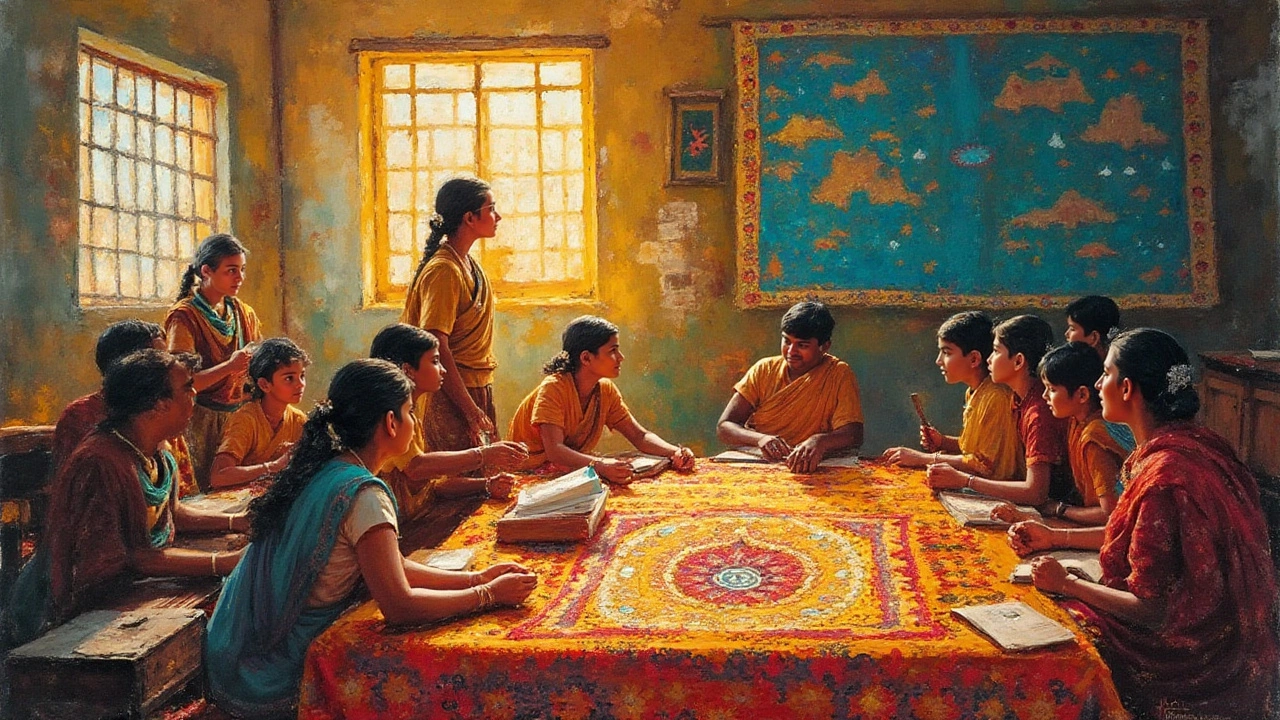India, with its vast diversity, embraces a multitude of languages. Yet, English has carved a special niche, becoming a vital link connecting various linguistic groups. The journey of English in India is intriguing, marked by historical events and evolving cultural dynamics.
Originally introduced during the colonial era, British English has significantly influenced the way it is spoken and taught throughout the country. Today, English is a mainstay in education, media, and business. But which dialect truly dominates?
This article aims to unravel the complexities of English usage in India, shedding light on its different forms. It will serve as a guide for those looking to hone their language skills through courses tailored to Indian English. Dive in to discover how English has shaped and continues to shape the linguistic landscape of India.
- Historical Impact of English in India
- British Influence and Its Legacy
- Neutralizing Accents in Indian Schools
- English Varieties in Indian Media
- Choosing an English Course in India
Historical Impact of English in India
The story of English in India is an extraordinary tale stretching over centuries. When the British East India Company first set foot in India in the 17th century, they couldn't have foreseen how deeply English would embed itself into the Indian cultural and educational fabric. The journey began with simple trade, but as the British clout in India ascended, so did the role of English. By the mid-19th century, Lord Macaulay's Minute on Education, 1835, famously made the case for using English as the medium of instruction, which he believed would foster a class of persons 'Indian in blood and color, but English in taste, in opinions, in morals, and intellect.' Macaulay's vision led to English becoming the language of governance and education, a legacy that prevails even today.
Across the vast land of India, British English laid down its roots, significantly influencing not just administrative practices but also literature and the arts. More Indians began to write in English, leading to a rich tradition of Indian English literature that includes celebrated authors like R.K. Narayan and Salman Rushdie, whose works gained international renown. English became the aspirational language, symbolizing modernity and progress, much like the railway networks the British established to connect distant corners of the country. The burgeoning middle class saw proficiency in English as a ticket to economic and social advancement, leading to its extensive presence in education systems across India.
Even after India gained independence in 1947, the pragmatic value of English ensured its persistence as an 'associate official language.' This ensured a smooth governance transition as English offered a neutral ground amidst diverse linguistic preferences. As India transformed into a burgeoning democracy, English played an integral role in unifying people from myriad linguistic backgrounds, making it not just a language imposed by colonial rulers, but one that Indians themselves adopted as a vehicle for national unity and growth. Given India's linguistic diversity, adopting English also addressed the issue of regional language clashes, acting as a bridge between disparate regions.
Interestingly, the liberalization of the Indian economy in the 1990s further propelled the demand for English. As businesses globalized, so did the need for communication in a universal language, putting English at the forefront of educational and professional opportunities. English medium schools flourished, not just within urban centers, but even in rural stretches, illustrating how deeply English had woven itself into the aspirational fabric of Indian society. A survey conducted in 1997 estimated that about one-third of the Indian population had rudimentary knowledge of English, a number that has only grown with time.
"India is not simply plural, it is pluralist." —Amartya Sen
This pluricultural nature is what makes the Indian English phenomenon so enthralling and significant. From media to technology, the influence of Indian dialects of English in various sectors is something even foreign businesses have started recognizing when they venture into India. Technology has only amplified this with the internet and digital platforms promoting the use of regional accents and dialects in global communication. It's fascinating how users blend local dialects with English terms, creating unique, colloquial versions of English commonly known as Hinglish, Tanglish, among others. The vibrant and evolving nature of this language reflects India's continuous journey of reinvention through its embrace and adaptation of English.
British Influence and Its Legacy
The British influence on the Indian subcontinent extends far beyond just infrastructure and politics; it is deeply etched into the language itself. English, as introduced by the British, was initially a tool of administration and governance, ensuring control over various regions. With time, it found its way into the educational system, becoming a medium of instruction for many schools and colleges. This was primarily because the British saw English as a way to create a class of intermediaries—Indians who could mediate between the rulers and the ruled. It's fascinating how their strategy also set a linguistic precedent that still persists and thrives in modern India, where English serves as a unifying language amongst the diverse vernacular tongues.
The impact of English manifests vividly in various domains such as law, where British legal terminologies still hold ground, and in academics, where English remains predominant. Interestingly, the British education system's hallmark — the emphasis on rote learning — has also permeated into the English courses offered in India. Much of this system was outlined to produce clerks, required in the colonial administrative apparatus. There's a charming anecdote about how Mahatma Gandhi once criticized the education policy by saying it made Indians mere imitators of European learning. This historical context has invariably shaped how English courses are taught and received in Indian institutions today, reflecting colonial undertones adapted for a post-colonial environment.
English didn't remain static but evolved dynamically through interactions with indigenous languages. The result is a distinct form of English, replete with Indian cultural context, idiosyncrasies, and vernacular influence. Moreover, British English served as the foundation, but modern Indian English has borrowed, twisted, and nativized phrases to suit the local palette. Expressions like "prepone" (the opposite of postpone) or "cousin-brother" showcase the creative adaptability of Indians, blending British structures with indigenous flair. Beyond linguistic aspects, this evolution reflects cultural pride, subtly resisting colonial remnants even while thriving within its frameworks. Rabindranath Tagore once eloquently stated, "The highest education is that which does not merely give us information but makes our life in harmony with all existence." This rings especially true for the intricate dance between Indian and English cultures over time.
The legacy of British influence is evident in the hierarchy of languages, with English often being associated with prestige and modernity. In urban centers, proficiency in English increases one's chances of career advancement and social mobility, which reflects the historical divide created during the British rule, albeit in a new form. Courses focusing on Indian English often undertake roles to neutralize regional accents, an effort carried forward from colonial times when the British aimed to create a more uniform administrative cadre. However, this standardization sometimes overlooks the inherent beauty and richness of India's diverse dialects.
For those enrolling in English courses in India today, understanding this historical backdrop is crucial. It's more than just learning a language; it's about grasping the cultural and political interplay that shaped its role in society. As India continues to assert its presence globally, the fusion of British legacy and indigenous resilience in Indian English emerges as a fascinating study of language evolution.

Neutralizing Accents in Indian Schools
In a country as linguistically diverse as India, the way English is spoken can vastly differ from one region to another. This has led to a concerted effort within the educational system to neutralize accents, particularly in English medium schools. Neutralizing accents in India is not about erasing the rich tapestry of regional dialects, but rather ensuring that students can speak in a way that is widely understood on a global scale. It involves teaching students a more standardized form of English, often modeled on British English due to historical connections. This standardization can help students from different regions communicate more effectively with each other and with international peers.
One of the main strategies used in schools is through extensive practice in pronunciation. Language labs in many Indian schools are equipped with technology that allows students to listen to native speakers and practice their speech. Teachers employ various phonetic exercises, helping students to grasp the subtle nuances of sounds which might not exist in their mother tongue. Place emphasis is often placed on problem sounds that are challenging for Indian students, such as differentiating between the sound of 'v' and 'w'.
Additionally, certain schools have embedded accent training as part of their curriculum. This training involves intensive conversational practice, listening to English music, engaging with international media, and even mock interviews. Speaking clubs and drama activities further reinforce these skills, offering a platform for students to practice their English in real-life scenarios.
Importance of Teachers and Technology
Teachers play a crucial role, employing individualized feedback for students to target their specific accent-related challenges. With the rise of digital learning tools, schools have started integrating software that uses AI to provide immediate feedback on pronunciation. The ability to use technology allows a personalized learning path, making it easier for students to track their progress over time. Indian dialects are diverse, and technology bridges that diversity, providing a universal method of learning English.
"Good pronunciation is not about acing accents; it's about carrying your message across clearly." – Anonymous Language Expert
Some schools have taken things a step further, forming partnerships with international institutions to bring exchange programs. These programs promote cultural and language exposure, presenting students with firsthand opportunities to practice neutral accent English with native speakers. This immersive experience often results in significant improvements, all while broadening students' global perspectives.
English courses in Indian schools now prioritize accent neutralization not because one way of speaking is superior to another, but because it unlocks doors to opportunities. But it doesn't stop with school education; many tutoring centers across the country are also offering specialized courses for accent neutralization, tailored for different proficiency levels. As English continues to be a lingua franca in global communication and business, the ability to speak in a universally understood accent is a valuable skill in the modern world. Students embarking on this journey find themselves better prepared for future academic and professional scenarios, both within and outside India.
English Varieties in Indian Media
English in India is as varied and dynamic as the country itself, and nowhere is this more evident than in media. The vast landscape of Indian media showcases a myriad of English varieties, each reflecting the diverse culture and regional influences of the subcontinent. From news channels to radio, and newspapers to digital platforms, the presence of English is widespread and significant. English-language newspapers such as 'The Times of India' and 'Hindustan Times' are known to follow British English standards, yet over time, they have organically incorporated local phrases, making them relatable to the Indian audience. Radio shows, meanwhile, often blend Hindi with English — sometimes humorously dubbed ‘Hinglish’ — especially in entertainment segments, highlighting the ease with which speakers switch languages. It's an articulate dance of phrases where sentences breeze seamlessly between languages without losing the listener.
Television news broadcasts strive for a more standardized form of English, yet subtle variations reflect the reporter's regional influences. Popular television networks like NDTV or India Today sometimes present anchors with a noticeable Indian accent, which adds to the authenticity and helps retain viewer engagement. An intriguing dimension is how movies and television dramas dabble in English dialogues, targeting urban audiences proficient in the language. This mix of dialogues reflects the urban lifestyle, where English is often the language of education and business.
Digital media, ever-evolving and fast-paced, has had a major impact on English usage. Yet, irrespective of the platform, certain expressions have now become ingrained in popular culture. Terms like ‘prepone’ (a reverse of postpone) are uniquely Indian, and often slip into spoken and written English, finding space even in informal English courses. Even popular web series on streaming platforms like Netflix and Amazon Prime borrow the local flavor, offering subtitles that often blend English with regional languages, catering to a diverse audience base. According to a study by Internet and Mobile Association of India, English is the second most-used language on the internet in India, reinforcing its significant role in digital communication.
Indian dialects of English not only cater to local nuances but also showcase India's adaptability to global culture. As a reader tunes into Indian media, they are greeted with a vibrant tapestry of expressions, both entertaining and educational. Interestingly, many international viewers and listeners find the Indian media's refreshing take on English both intriguing and appealing. As one media critic puts it, "Indian English is not just a language; it's an identity, a reflection of the country's past and present harmoniously interwoven." This unique narrative is why English courses in India often focus not just on standard British or American English, but also on Indian English as a legitimate, growing dialect deserving global recognition.

Choosing an English Course in India
Embarking on the journey to master English in India involves several considerations. Given the diverse application of English across the country, selecting the right course can profoundly impact one's learning trajectory. With the prominence of English courses throughout India, you'll find programs tailored to varying levels, needs, and professional aspirations. When choosing an English course, the first step is defining your goals—be it for academic enhancement, professional development, or personal enrichment.
The type of English you wish to learn plays a significant role. Some courses focus heavily on British English due to its historical roots in India, reflecting the language norms used in formal settings and educational institutions. Meanwhile, other courses emphasize neutralizing regional accents to appeal to international standards. This is particularly crucial in fields like customer service or Information Technology, where communication might span continents.
According to a study by EF Education First, English proficiency in India was significantly improved among individuals who resided in urban areas where these courses are prevalent.
When evaluating potential programs, consider the institution's reputation and the qualifications of the instructors. Established centers, sometimes affiliated with international bodies, may offer more credible certifications. It's wise to explore alumni reviews or speak directly with previous participants to gauge the effectiveness of the teaching methodology. While local language schools might offer competitive rates, the course content and delivery are critical to ensure value. Indian dialects influence the way English is taught in India, and a good program should address these nuances extensively.
Flexibility is another aspect to ponder, especially for working professionals. Many courses now offer digital classes or hybrid models, providing valuable flexibility for learners balancing work and study. Online courses can provide a cost-effective solution, allowing learners to progress at their pace with a plethora of digital resources at their fingertips. The expansion of technology in education has made learning accessible to enthusiastic learners beyond geographical limitations, transforming how English is perceived and learned across the nation.
A critical feature to consider is the inclusion of practical communication exercises, such as group discussions, debates, and interactive sessions. These help bolster confidence and practical understanding of the language in real-life situations. Many top-tier courses also offer modules in media literacy, encouraging students to engage with English through Indian and global media, thus bridging theoretical learning and practical application.
The decision to enroll in an English course is enriching and multifaceted, influenced by personal goals and the distinctive linguistic landscape of India. Whether aspiring to enhance one's career, travel, or partake in cultural exchanges, choosing wisely amongst the myriad of English courses in India can open new doors and pathways to growth.

